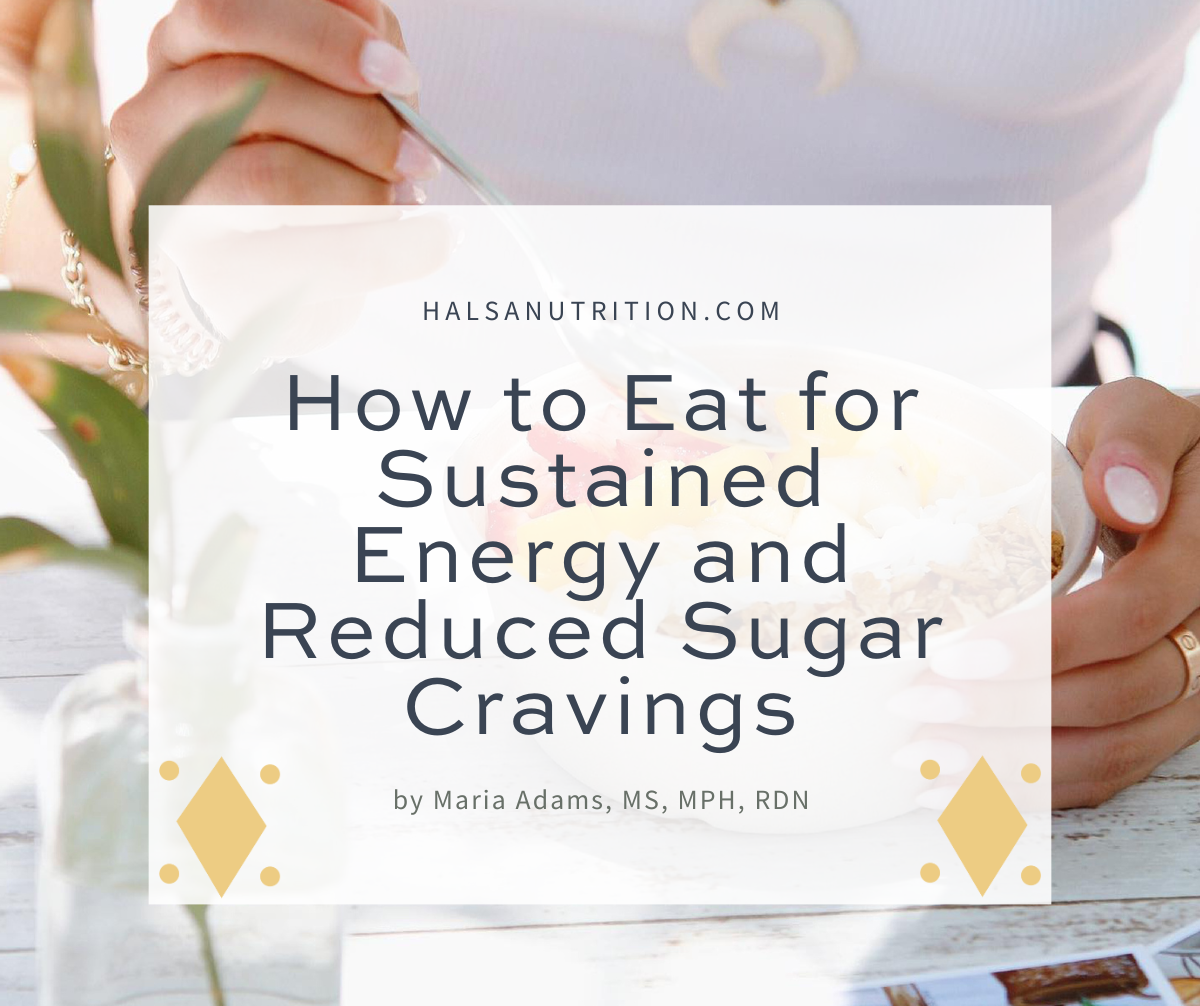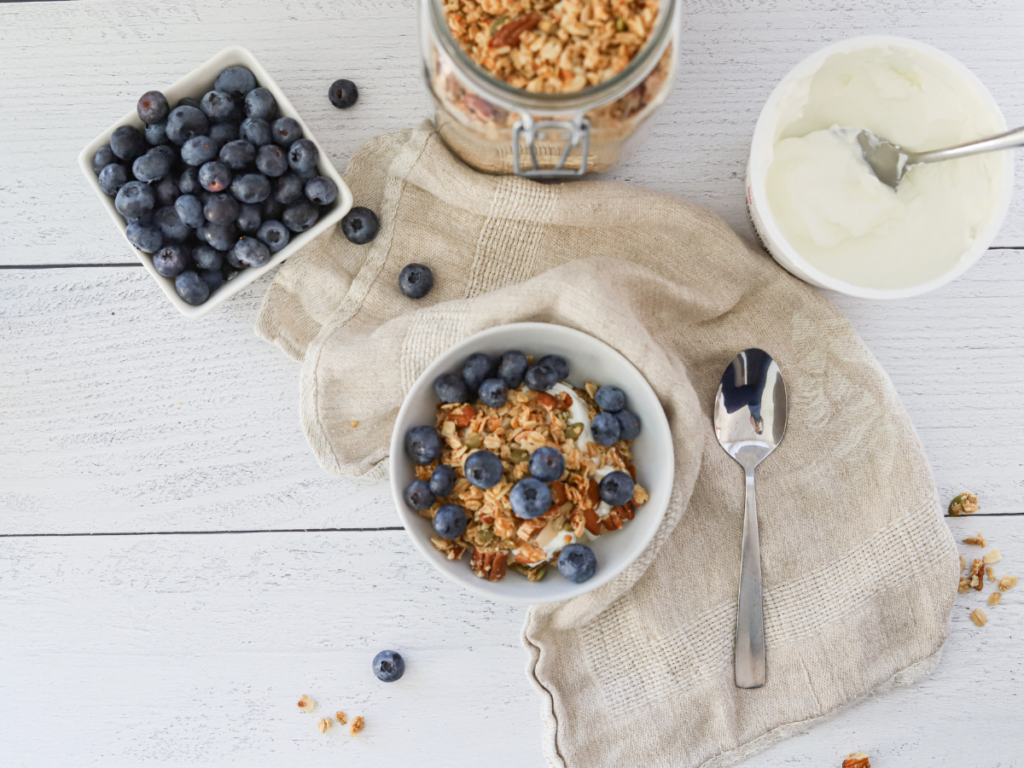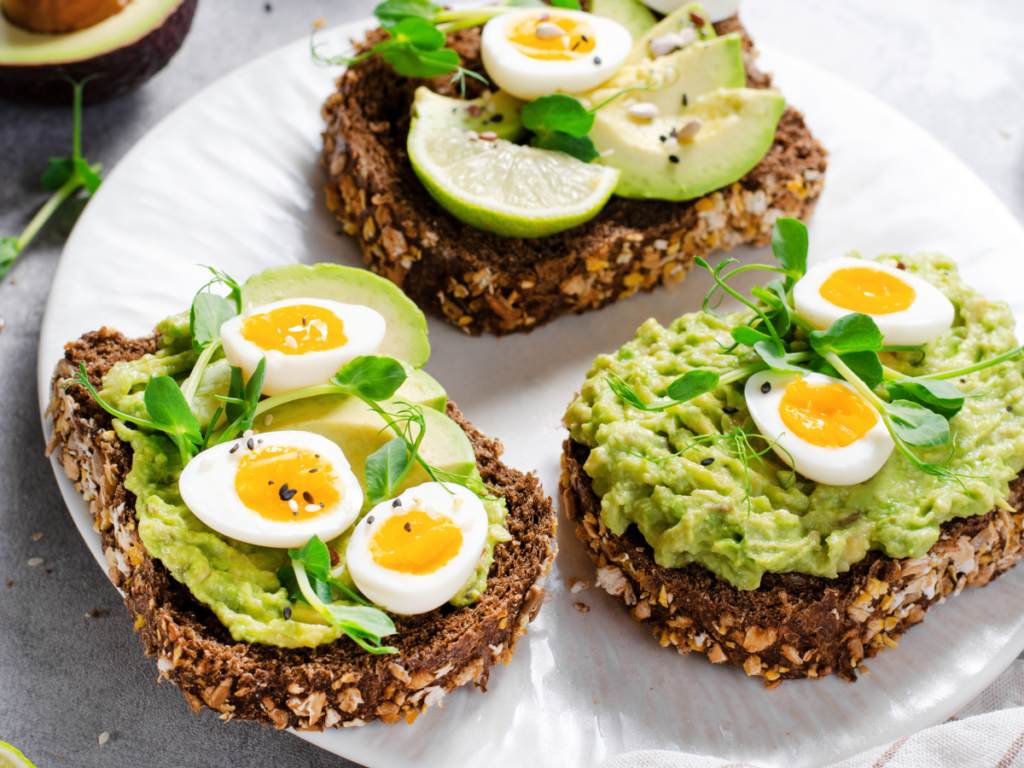
How to Eat for Sustained Energy and Reduced Sugar Cravings
Estimated reading time: 10 minutes
How and what you eat throughout the day can help you stay energized and feel your best. If you eat for sustained energy, it can help whether you are prone to crashing mid-afternoon, struggling with sugar cravings, or feeling sluggish. Learn about habits that help you stay fueled and sharp throughout the day.
Here are seven suggestions for eating for sustained energy and other related lifestyle factors to consider.
1. Eat enough throughout the day.
Spread your energy intake throughout the day. For most people, it helps to follow the meal structure of 3 meals and 1-3 snacks per day. That said, there is no one right way to eat. Some people prefer six small meals, others two larger meals plus snacks, while others skip the snacks altogether. You do you; listen to the feedback from your body and work with your current schedule and lifestyle to determine what works best for you. These are meant to be guidelines.
When it comes to how much to eat, tune into your body’s hunger and fullness signals. There will be some days when you are hungrier than usual and others when you are less hungry. It’s important to honor what your body tells you and eat when you are hungry–regardless of when it is.
In addition to spreading your calories throughout the day, aim for balance, variety, and satisfaction at each meal and snack. However, be realistic and flexible; chances are you won’t have a perfectly balanced and delicious meal every time you eat.

2. Start the day with a nourishing breakfast.
Break the overnight fast with a nourishing breakfast. While a pastry with coffee is a fun breakfast now and then, chances are it won’t keep you satisfied that long. So, when possible, include a balance of foods and nutrients in your breakfast. Having fiber-rich carbs, fat, and adequate protein will maximize the lasting power of your meal. (Think F, F, P–fiber, fat, protein). Including fiber in your meal helps slow the release of sugar into your bloodstream; fat and protein also slow digestion.
Breakfast ideas: oatmeal with blueberries, walnuts, cinnamon, and milk; overnight oats with fruit; Greek yogurt with berries and granola; avocado toast with smoked salmon; egg sandwich with sliced tomato on whole grain toast; sweet potatoes + veggie omelet; croissant + green smoothie with protein.
3. Have planned snacks to get you from one meal to the next.
Snacks help bridge the gap between meals. They can help keep our energy going and prevent us from getting over-hungry. Most people need to eat every 3-4 hours, but you may need to eat sooner than this if you didn’t eat enough at the previous meal. You may be able to go 5 hours, but this increases the likelihood of being ravenous at the next meal. Studies support eating snacks.
Choose a snack you enjoy. When possible, include fat, fiber, and protein in your snack (but stick to primarily simple carbs and lean protein if you plan on intense exercise in the next hour or so). As with all meals, focus on mindfully eating your snack when possible. Pause from whatever you are doing to select and savor your snack. (And consider implementing a Swedish-style fika break in your office!)
Snack ideas: apples + cheese; pear + Greek yogurt; grapes + turkey slices; crackers + hummus; tortilla chips + salsa and guacamole; edamame dip + crackers; cereal + protein-rich milk; latte + oatmeal cookie; green or berry smoothie made with protein source; banana bread + peanut butter; open-faced sandwich with ham and sliced bell pepper; pumpkin muffin + almonds; protein bar + clementine.
4. Eat a balanced lunch.
If you are taking a break for lunch, that is a super start. Many people skip over lunch or delay it, which can cause you to get over-hungry later. Ideally, aim to eat lunch away from your desk when you can. This will help you switch from work mode to rest and digest mode. It can also make you more mindful about what and how much you eat.
When it comes to what’s in your lunch, aim for a balance of carbs, protein, and fat. Choosing a lunch high in produce, whole grains, and lean protein may help you with sustained energy into the afternoon. When a meal is heavy in fat or simple carbohydrates, it’s more likely to increase sluggishness. Eating less food can also help reduce fatigue; ideally, listen to your body and stop eating when you are comfortably full.
Lunch ideas: leftover dinner (e.g., salmon, brown rice, broccoli, and carrots) + fruit; lentil soup + pita bread with cheese; turkey sandwich on whole grain bread with veggies + apple + dark chocolate; salad with grilled chicken and quinoa + orange; whole grain bread with avocado, egg, and microgreens.

5. Stay hydrated throughout your day.
Staying hydrated will help you feel alert and energized. Even mild dehydration can result in fatigue, which may have us reaching for sugar when we need water. While all non-alcoholic liquids (and water-rich foods like melon and soup) help you stay hydrated, there are many reasons to make water your go-to hydration source. For one, it’s usually readily available and free; two, you can easily sip it at your desk or on the go; and three, it doesn’t add to your daily sugar or caffeine intake. A good way to check your hydration level is by the color of your urine: if it’s clear or straw-colored, you are probably well-hydrated; if it’s darker, try drinking more water and see if that helps.
6. Have a relaxed, mindful dinner.
While dinner may be the meal that people are least likely to skip, it has its challenges. In our time-pressed world, many people find planning and cooking dinner stressful. Add to that the fact that family members may have different schedules and that many of us are tired and worn out by the end of the day. In addition, many people find themselves over-hungry by dinner time because they don’t eat enough earlier in the day. All this makes eating well at dinner challenging!
Here are some tips to help you eat well at dinner:
- Plan and shop ahead of time.
- Cook one meal for the family; don’t be a short-order cook. With time, this will help reduce picky eating and help promote a healthy relationship with food for all.
- Enlist help from your family with at least one part of the process, whether planning, shopping, cooking, setting the table, or cleaning up.
- Practice mindful eating. This can help us tune into what our body needs and stop eating when comfortably full.
- Reduce stress. Eating mindfully, enjoying our food, and remaining patient if we are stressed is hard. If dinnertime stress is an issue, work to reduce it before dinner. Make sure you are fitting in self-care.
- Don’t get over-hungry before dinner. If you are the chef, start by ensuring you have enough in the tank to dedicate energy to making dinner. If it’s hard to fit in an afternoon snack, consider a pre-dinner appetizer that will help reduce your hunger and allow you to prep dinner more calmly.
- Create a relaxed and enjoyable dinner environment when possible. Lighting candles, playing relaxing music, and engaging in positive, low-stress conversations at the table can help.

7. Fine-tune your caffeine consumption.
Enjoy caffeinated drinks such as coffee and tea in whatever way serves you best. The coffee and tea routine is often very sacred and personal. If it’s working for you, keep it. But if you are curious whether it could negatively affect your energy or health, try adjusting it. Here are some points to consider.
- To promote hydration and energy, consider having a cup of water before you reach for your morning coffee or tea.
- Our body naturally releases the hormone cortisol in the morning to help us wake up, so some people say they feel better when they delay their morning caffeine to when these levels drop.
- Experiment with your caffeine dosage. If a full 12-ounce cup of coffee leaves you jittery and causes you to crash a few hours later, what happens when you decrease it to 4-6 ounces? (Then, have the other 4-6 ounces a few hours later if desired. I call this the European style of drinking coffee.) Or maybe you try switching to half-caf?
- Many people sleep better when limiting caffeine to the first half of the day, while others feel their sleep is not affected and enjoy the pick-me-up of an afternoon coffee.
- If your sleep isn’t affected, having a small dose of coffee after lunch or in the early afternoon can provide a welcome energy boost–and a chance for a break from your desk.
Ultimately, how and when you prefer your coffee or tea is very personal, so do what works best for you and brings you joy.
Other factors that affect energy and sugar cravings
Movement
Include regular movement throughout your day. Getting to the gym or out for a walk in the morning is excellent, but it’s good to continue to have movement throughout the day. Engaging in movement is a great way to reduce fatigue, and any movement counts. For example, if you have a desk job, even standing up intermittently throughout the day can help! Other suggestions include walking or biking to work, adding an afternoon or after-dinner walk, taking calls while standing up, and choosing hobbies that require some physical activity.
Sleep
A good night’s sleep is integral to eating well. When we don’t get enough sleep, we tend to crave sweets and make less “healthy” choices. While getting enough quality sleep isn’t always in our control, try to prioritize it if possible. Sticking to a consistent bedtime and a routine that includes a bedtime snack may help. Choose a snack that you enjoy, but limit high-sugar or hard-to-digest foods; note that alcohol and caffeine both negatively affect sleep. Other habits to consider include putting away the phone and instead reading a book, listening to music, journaling, or meditating.
Stress
Healthily manage stress. When stressed, we get into fight or flight mode, and our blood sugar rises, which can lead to later energy crashes. So, incorporate strategies that work for you, whether going outside for fresh air, exercising, listening to music, meditating, doing yoga, watching a funny show, or calling a friend.
It’s also essential to set barriers and prioritize self-care. Additionally, recognize that you don’t have control over anything but your own actions and reactions. So try not to get ruffled by things that are ultimately out of your control; focus on your response instead.
For more support with eating to optimize daily energy levels
If you want more personalized guidance on eating for sustained energy, consider contacting a Registered Dietitian Nutritionist. They can help you assess if your diet could be more balanced or is falling short in nutrients such as B vitamins, Magnesium, or total calories, which could also affect your energy. They can also work with you to set SMART goals, prioritizing your health and well-being one small action at a time.
About the author
Maria Adams, MS, MPH, RDN, LDN, a registered dietitian and Certified Intuitive Eating Counselor. Maria takes a weight-inclusive approach and helps individuals rediscover the joy of food, learn how to nourish to feel their best, and heal from chronic dieting and disordered eating. She holds a Bachelor of Science Degree in Nutrition Science, a Master of Science in Nutrition Communication, and a Master of Public Health.
Leave a Reply